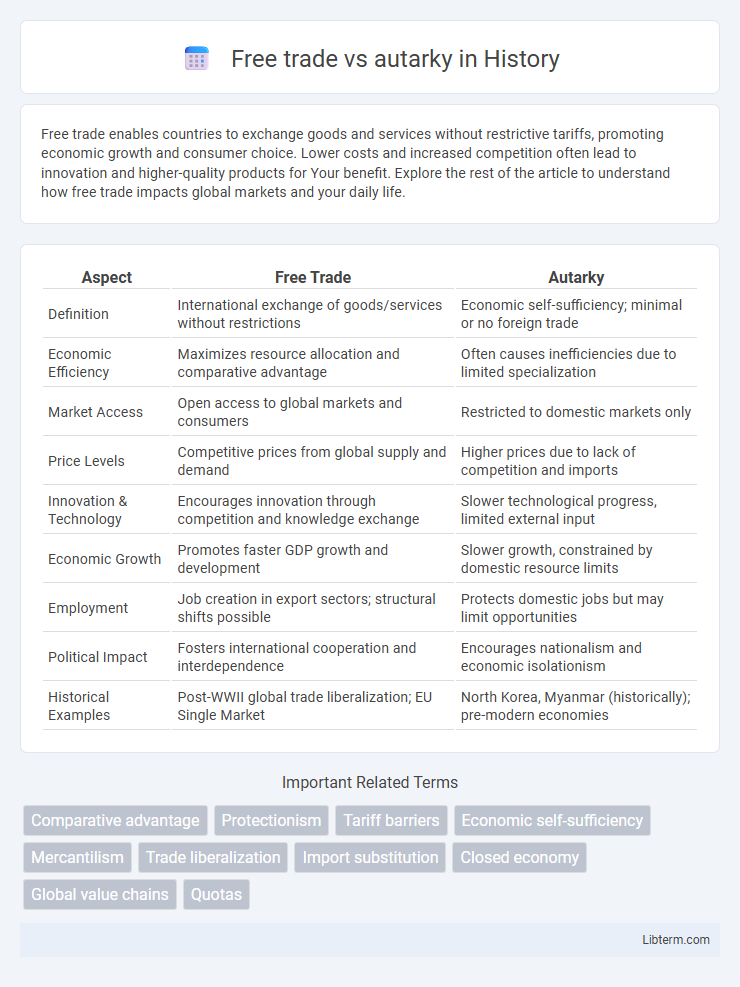Free trade enables countries to exchange goods and services without restrictive tariffs, promoting economic growth and consumer choice. Lower costs and increased competition often lead to innovation and higher-quality products for Your benefit. Explore the rest of the article to understand how free trade impacts global markets and your daily life.
Table of Comparison
| Aspect | Free Trade | Autarky |
|---|---|---|
| Definition | International exchange of goods/services without restrictions | Economic self-sufficiency; minimal or no foreign trade |
| Economic Efficiency | Maximizes resource allocation and comparative advantage | Often causes inefficiencies due to limited specialization |
| Market Access | Open access to global markets and consumers | Restricted to domestic markets only |
| Price Levels | Competitive prices from global supply and demand | Higher prices due to lack of competition and imports |
| Innovation & Technology | Encourages innovation through competition and knowledge exchange | Slower technological progress, limited external input |
| Economic Growth | Promotes faster GDP growth and development | Slower growth, constrained by domestic resource limits |
| Employment | Job creation in export sectors; structural shifts possible | Protects domestic jobs but may limit opportunities |
| Political Impact | Fosters international cooperation and interdependence | Encourages nationalism and economic isolationism |
| Historical Examples | Post-WWII global trade liberalization; EU Single Market | North Korea, Myanmar (historically); pre-modern economies |
Introduction to Free Trade and Autarky
Free trade promotes the unrestricted exchange of goods and services between countries, enhancing economic efficiency and consumer choice by leveraging comparative advantage. Autarky, in contrast, refers to a country's pursuit of economic self-sufficiency by minimizing or eliminating reliance on international trade. Understanding these concepts is crucial for analyzing the impact of trade policies on national economies and global markets.
Defining Free Trade: Key Concepts
Free trade refers to the unrestricted exchange of goods and services across international borders, eliminating tariffs, quotas, and other trade barriers to enhance economic efficiency and consumer choice. Key concepts include comparative advantage, where countries specialize in producing goods with lower opportunity costs, and market openness, which fosters competition and innovation. This framework contrasts with protectionist policies by emphasizing the benefits of global integration and resource allocation optimization.
Understanding Autarky: Principles and Goals
Autarky emphasizes economic self-sufficiency by minimizing reliance on international trade, aiming to protect domestic industries and reduce vulnerability to external market fluctuations. This policy advocates for local production of essential goods to ensure national security and preserve employment within the country. The principles of autarky involve strict regulation of imports, tariffs, and state intervention to prioritize internal resource utilization and sustain economic independence.
Historical Perspectives on Trade Policies
Historical perspectives on trade policies reveal that free trade has often spurred economic growth by enabling countries to specialize based on comparative advantage, as seen in 19th-century Britain's repeal of the Corn Laws. Autarky, pursued by nations like North Korea and Nazi Germany, aimed for economic self-sufficiency but frequently resulted in inefficiency and stagnation. Economic historians highlight that open trade policies have generally correlated with increased innovation, higher productivity, and improved living standards throughout modern history.
Economic Impacts: Growth and Efficiency
Free trade promotes economic growth by enabling countries to specialize in industries with comparative advantages, leading to higher productivity and efficient resource allocation. Autarky limits market access and competition, often resulting in inefficient production, higher costs, and slower technological progress. Empirical studies show that economies engaging in free trade typically experience accelerated GDP growth and improved consumer welfare compared to isolationist policies.
Effects on Consumers and Producers
Free trade typically benefits consumers by providing access to a wider variety of goods at lower prices due to increased competition and specialization. Producers in countries with competitive advantages can expand markets and achieve economies of scale, boosting efficiency and profits. In contrast, autarky limits consumer choice and often leads to higher prices, while producers face restricted demand and reduced incentives for innovation and efficiency.
National Security and Strategic Interests
Free trade enhances national security by fostering economic interdependence, making conflicts less likely while ensuring access to critical resources and technologies. Autarky prioritizes strategic self-sufficiency, reducing reliance on foreign supply chains vulnerable to disruption during geopolitical tensions. Balancing open trade policies with domestic production capabilities supports both economic strength and the safeguarding of essential national security interests.
Environmental Considerations
Free trade encourages resource efficiency and the adoption of green technologies by enabling countries to specialize based on comparative advantage, which can reduce overall environmental impact. Autarky often leads to less efficient resource use, increased pollution, and higher energy consumption as nations must produce all goods domestically without benefiting from global ecological optimizations. However, free trade can also cause environmental harm due to increased transportation emissions and the potential for regulatory "race to the bottom" in environmental standards.
Case Studies: Successes and Challenges
China's shift from autarky to free trade since the late 20th century propelled its economic growth, with exports accounting for over 38% of GDP by 2023. Conversely, North Korea's persistent autarkic policies contributed to chronic economic stagnation and limited global trade engagement. Case studies reveal that free trade generally boosts innovation and efficiency, while autarky can protect domestic industries but often at the cost of economic isolation and reduced consumer choice.
Conclusion: Balancing Trade and Self-Sufficiency
Free trade enhances economic efficiency by allowing countries to specialize and benefit from comparative advantage, leading to increased consumer choice and lower prices. Autarky prioritizes self-sufficiency and national security but often results in higher production costs and limited innovation due to reduced competition. A balanced trade strategy integrates selective protection of strategic industries with open markets to optimize economic growth and resilience.
Free trade Infographic

 libterm.com
libterm.com